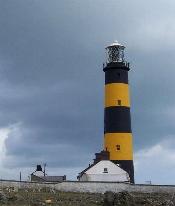|
|
St John's Lighthouse. 54°13.6' North |
| |
Co
Down. |
||
|
The St Johns lighthouse The tower was increased to 102 feet some time in the 1890's and the lantern seen today was put in place, it was during this renovation that an auxiliary light was fitted on the third floor to assist navigation inside Dundrum Bay, a fog signal was installed and the station converted to coal gas, which entailed the construction of a gas plant two gasometers and housing to accommodate the extra staff required The lantern in common with many other's floats in a circular bath of mercury to reduce friction. The engine house houses several antique engines, two Ruston Hornsby horizontal's driving compressors were formally used to power the foghorn which is now electrical. Within the walled enclosure of the grounds are several quaint keepers cottages, which are used occasionally when service engineers are working on the light. St. John's light began opperating as a fully atomatic light on 31st May 198i Shortly after the construction of the light, the worlds first iron steamship The Great Britain designed by Isambard Kingdom Brunel ran ashore on the beach at Tyrella a few miles west of St Johns. The charts aboard the Great Britain did not show the newly completed light and the captain took it to be a light on the Scottish coast and set a course to the west of it. The ship spent the winter on the beach and was re-floated the next spring with the aid of a 600 hp naval warship. Other notable shipwrecks in the area are the Georgetown Victory an American troopship which went ashore on Killard point at the mouth of Strangford Lough at the latter end of World War II, the ship was broken up where she lay. In 1798 the Amitý a French ship carrying arms and cannon destined for the United Irishmen's Rebellion went ashore at the village of Sheeplands a little to the south of Strangford bar, all hands but one were lost, click here for the story. |
||
|
|
| |
